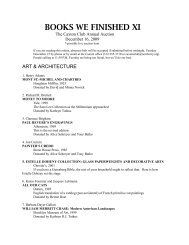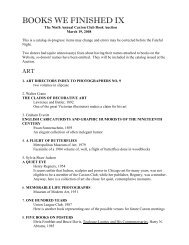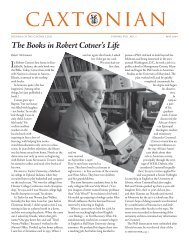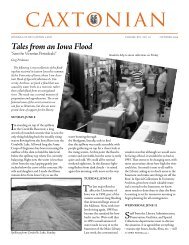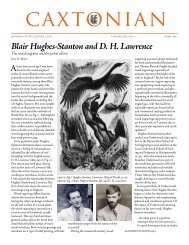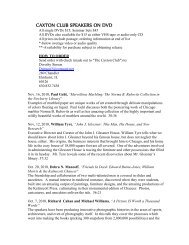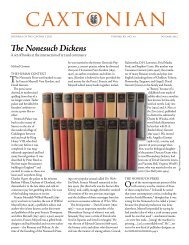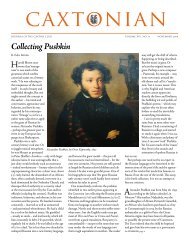Easter Egg Chickens - The Caxton Club
Easter Egg Chickens - The Caxton Club
Easter Egg Chickens - The Caxton Club
Create successful ePaper yourself
Turn your PDF publications into a flip-book with our unique Google optimized e-Paper software.
Jacket, title spread, and inscription from the author’s<br />
copy of A Mighty Evergreen Forest.<br />
EASTER EGG CHICKENS, from page 5<br />
Brower picked up an olive-green egg, the<br />
color of a Boy Scout uniform, and said, “Now,<br />
I want to show you something.” With a startling<br />
crunch, he cracked the egg open on the<br />
edge of a table, deftly sliding its contents into<br />
one open palm. <strong>The</strong> yolk was almost spherical,<br />
bright yellow like the National Geographic’s<br />
border. He passed the broken shell to each of<br />
us. “<strong>The</strong>se shells are green on the outside and<br />
blue on the inside, see? That’s because it’s a<br />
cross between a brown egg and a blue egg, and<br />
the color of a brown egg is only on the surface<br />
of the shell, but the color of a blue egg goes<br />
all the way through.” I had eaten brown eggs<br />
before, but that detail had entirely escaped<br />
my attention. As Sherlock Holmes once said<br />
to Dr. Watson, there is a difference between<br />
seeing and observing.<br />
I asked Brower what he did with the eggs.<br />
He told me they were for sale, but there<br />
weren’t many buyers. In 1950, he had told the<br />
New Yorker writer that the eggs sold for $1.50<br />
each, while the chickens ranged in price from<br />
$25 to $1,000 – a whole lot of money in those<br />
days. Of course, Brower had spent almost<br />
two decades breeding the chickens, experiencing<br />
one failure after another, before he<br />
achieved success. So he might be forgiven for<br />
6 CAXTONIAN, AUGUST 2012<br />
thinking the results were worth rather a bit<br />
more than the frozen birds you could buy at<br />
the local Safeway.<br />
One of the Kodachromes in the National<br />
Geographic article showed Brower’s pretty wife<br />
and three of their children holding another<br />
pet, a white duck with a plume of black<br />
feathers sprouting from the top of its head,<br />
looking something like Robin Hood’s hat.<br />
<strong>The</strong> young boy in the photo was Ward Brower<br />
III. Recently, I talked to him by phone. He<br />
was easy to find. He still lives in Monroe, and<br />
if you Google the name “Ward Brower,” he<br />
comes up far more frequently than his father,<br />
usually in minutes of the Monroe Town<br />
Board reflecting his critical remarks during<br />
the public comment period. I found an article<br />
in the local newspaper that described him as<br />
“part of the loyal opposition that attends every<br />
board meeting.”<br />
Ward III is in his 60s now. When he was<br />
a child, reporters were constantly stopping<br />
by the house to ask about the chickens. “We<br />
thought it was the norm,” he told me. Professors<br />
from Columbia University took their<br />
students on field trips<br />
to visit the Columbia<br />
dropout and his birds.<br />
Ward III was even on<br />
TV. Most of that publicity,<br />
including the New<br />
Yorker piece and a picture<br />
spread in the American<br />
Magazine, was in the<br />
1950s. I asked Ward III<br />
why there was so much<br />
press at that time. “It was<br />
all from the National Geographic<br />
article,” he said. “It<br />
shows you the power that magazine has.”<br />
In the early 1970s, just a few years after our<br />
visit, Ward Brower moved the family back<br />
to Sullivan County. It seems he experienced a<br />
wave of nostalgia for his childhood: in 1974 he<br />
published a small book about the area titled A<br />
Mighty Evergreen Forest. Part memoir and part<br />
a plea to save the remaining wild area from<br />
development, Brower’s book vividly displays<br />
his characteristic fervor for educating people<br />
about the natural world. He writes:<br />
Words fail to express adequately the height,<br />
depth, or magnitude of such real unspoiled<br />
charm. <strong>The</strong> lofty peaks with their majestic<br />
shapes and rugged rocks, plus the good taste<br />
of nature’s living adornments. <strong>The</strong>y are giant<br />
white pines, the most beautiful of all the<br />
pine family; yellow pine, and the now famous<br />
Canadian hemlocks, whose seedlings are<br />
dwarfed by nurserymen and used for all sorts<br />
of landscaping ideas. I am a nurseryman, an<br />
organic nurseryman, and can show you the<br />
hemlock in many ornamental uses.15



